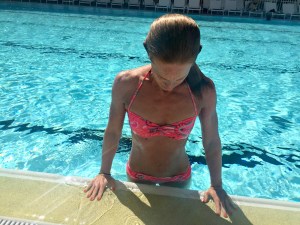7 Tips for Exercising in Hot Weather
Wowzas!!! 😎😎😎😎☀️☀️☀️☀️ no I’m not complaining…
I ❤️ it
but we need to know what to be mindful of when exercising in this heat so here are a few tips….
Firstly it’s always key to remember that in any weather – approx 10-15 mins into a workout your body temperature is always a few degrees above normal temperatures and so in higher temperatures this increases further and if you try to sustain exercise for too long you’ll get fatigue and other heat related problems.
However, these heat related problems can be avoided if we stay well hydrated, Drinking water is imperative for exercising in hot or humid weather.
Maintenance of body fluids is essential to maintaining proper body temperature. Sweat cools your body by evaporating off your skin. Visible beads of sweat that don’t evaporate only dehydrate you they don’t provide the beneficial cooling effect. If you let your body become dehydrated, you’ll find it much more difficult to perform even the lightest of workouts.
But don’t wait until you’re thirsty to start replenishing fluids. Chances are, by the time you actually feel thirsty, your body is well on its way to becoming severely dehydrated.
Here are the key factors to consider for hot weather exercise:
1. Hydration

Fluid replenishment before, during and after exercise is essential to avoid progressive dehydration. Water isn’t the only thing your body loses in sweat. Electrolytes such as sodium, potassium and chloride are also lost in sweat. It is equally important to replace these with a sports drink during continuous exercise lasting longer than one or two hours. (milk is good for this after exercise)
SO…..
2 hours before exercise drink 5-600ml water
every 10-20 minutes during exercise drink 2-300ml water
after exercise drink 450-675ml for every 0.5kg body weight lost
2. Exercise Intensity

You should reduce the intensity of your workout, particularly the first few times you are exposed to higher temperatures so be sure not to push yourself over board…
3. Temperature

High humidity prevents sweat from evaporating, and remember that sweat that does not evaporate does not cool the body.
While a 32° C outdoor temperature is relatively safe at 10% humidity, the heat stress of 32° C at 50% humidity is the equivalent of 35° C.
When the heat stress index rises above 32° C, you may want to consider postponing your exercise session until later in the day. Or, plan ahead and beat the day’s heat by working out early in the morning or late at night.
4. Heat Stress Index

When you go outside to exercise, refer to the heat stress index and consider the associated risks:
* Below 27° C: Little or no danger under normal circumstances
* 27–32° C: Fatigue possible with prolonged exposure
* 32–41° C: Heat cramps and heat exhaustion are possible
* 41–54° C: Heat cramps and heat exhaustion likely, heatstroke is possible
* Over 54° C: Heatstroke is imminent
5. Fitness

Exercise and heat acclimation can increase your blood volume, helping to regulate body temperature more effectively. Interestingly, the acclimatisation process can be completed in seven to 14 days of repeated heat exposure. However, you must always continue to drink fluids before, during and after exercise.
6. Clothing

Wear minimal clothing to provide a greater skin surface area for heat dissipation. Your clothing should be lightweight, loose-fitting, light-colored to reflect the sun’s rays and of a fabric that absorbs water, such as cotton or other moisture wicking material.
7. Rest

Know when to say “no” to exercise. Using common sense is your best bet for preventing heat stress when Mother Nature turns up the heat. (so if you’re already very dehydrated today and don’t have time to hydrate before your workout think twice about it.)
I hope that helps…Melissa x
Source: ACE Fitness










Leave a Reply
Want to join the discussion?Feel free to contribute!